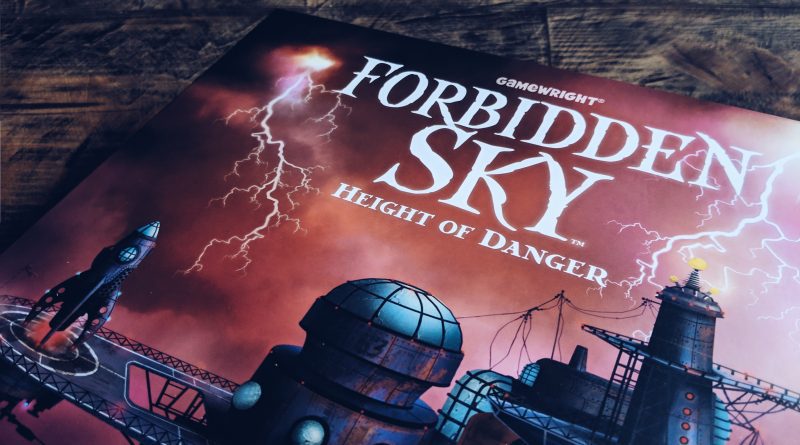Forbidden Sky
You survived a sinking island and made it to the chopper with some priceless artifacts, only to crash in a desert wasteland. That didn’t stop you. You scraped together various bits and pieces, and built a flying machine to escape the desert. Now you find yourself on a floating island in the middle of an electrical storm. You come across a rocket ship with enough space for all of your companions. Perfect! Only one problem. There isn’t enough power to start the launch sequence.
Today we’re looking at the third installment of the Forbidden series by Gamewright. Forbidden Sky is a cooperative tile placement game in which players must work together to complete a real electrical circuit before they are overwhelmed by the storm. Let’s take a look.

Unlike the first two Forbidden games which came in tins, Forbidden Sky comes in a more standard size cardboard box. I actually like this decision quite a lot – mostly because the tin for Forbidden Island always gave me trouble staying properly closed. Not an issue here. The cards are all printed well with consistent colors, and the tiles are printed on nice thick cardboard. If you’re familiar with Carcassonne, the tiles feel about the same.
The most unique thing about Forbidden Sky is the rocket ship. I’ll cover the mechanics more in a bit, but this rocket needs to be connected to other components in the game in specific ways in order to win – and it lights up when that happens. The rocket made of sturdy plastic – I even let my two year old play with it outside of the game because I’m relatively confident it won’t break.
It is worth mentioning that we’ve had some trouble getting the metal components to trigger the launch sequence at the end reliably, even when everything appears to be making a good connection. More often than not, we have to shuffle stuff around quite a bit before we get that satisfying beep sequence. We all know we won anyways, but it can be a little anticlimactic.
For fans of the series, the artwork will feel familiar. I particularly like the box art. The rest of the components look pretty neat, although it does look more like a science project than a board game. This is the allure of Forbidden Sky for me – It looks really interesting on the table, and never fails to draw a crowd.

To set up, each player gets an adventurer card, matching pawn, and two stat tracking clips for health and rope. Select a difficulty card, which will determine how many components need to be connected to the launch pad to win the game. Shuffle all the tiles together and place them in a face down pile – same with all of the storm cards and item cards. Set out the starting tile (the long one with the spinner on it), and place your player pawns on the starting space. Set the storm tracker to the desired player count, and you’re ready to go.
The goal in Forbidden Sky is to power the rocket your party will use to escape the sky platform. You’ll do this by connecting lightning rods and capacitors to the rocket’s launch pad – but make sure you place the last wire when you’re all on board, or someone will get left behind! On your way you’ll be utilizing your special set of skills to battle high storm winds and unpredictable lighting strikes.

On your turn, you take up to four of the available actions – Move, Scout, Explore, and Wire. Any of these actions can be taken multiple times as long as you only complete four total actions.
Move allows a player to move their pawn one adjacent tile (or through a teleporter).
Scout allows a player to draw a new tile – you may only have three tiles in your “hand” at a time.
Explore allows a player to place one of the tiles from their hand to an adjacent space, as long as at least one of the orange wires lines up. If the tile has a lightning rod symbol, or completes a capacitor icon, place the corresponding piece immediately.
Wire allows a player to connect or disconnect two conductive components with a conductive wire

After every player’s turn, draw a number of storm cards equal to the number on the storm tracker. This is where the game gets really rough. Storm cards can cause lightning strikes, gusts of wind, and even cause the storm to intensify (increasing the number of storm cards you draw). At higher player counts, this can mean you’ll get zapped or tossed off platforms multiple times before your turn comes back around, and can make the game feel pretty difficult, even on the easier difficulty settings.
There are ways to mitigate some of the risk to the player – between item cards, player abilities, and tile spaces that negate certain effects, it is certainly possible to survive – but it is by no means easy. While a lot of the player abilities are useful, we’ve had the most success with combinations that include the one that can restore health and the one that can restore rope.

As a huge fan of Forbidden Island, I went into Forbidden Sky with high hopes. I love that it continues the Forbidden story without getting stale. It brings over just enough familiar mechanics to make the game feel like it fits that world, while maintaining a completely distinct gameplay. Now I’ll admit, I still haven’t had a chance to play Forbidden Desert, but I’ve seen it played and pretty much understand the mechanics well enough to say that Forbidden Sky is both distinct and a natural progression from the previous two games. Side note, I absolutely plan on playing Desert as soon as an opportunity presents itself.
There are some things I don’t like as much about Forbidden Sky that are preventing it from topping Island in my book. First, it is a little more fiddly. The components are neat, and the light up rocket is a hit with the kids (and me, let’s be real), but getting everything to line up properly can be a pain.
I’m not usually one to complain about difficulty, but I will say that, especially at higher player counts, having multiple weather events happen between your turns can feel unnecessarily punishing. You could plan your move so that you end up on a safe space from lightning, but the next card could push you into a space that isn’t, and the next several cards could all be lightning, and you could go from hull health to dead before you have a chance to do anything to prevent it. This is offset a little bit by the game being cooperative – players can work together to try to protect each other, but more and more I’ve found the game plays best with two players because of this.
Even with the little qualms I have with the game, Forbidden Sky is undoubtedly fun. I still like Island better, but that doesn’t make Sky bad. I think the most likely time this one will hit the table is when a group particularly enjoys Island and wants more of a challenge. I’d love to play the series sequentially, and I may do that when I get my hands on a copy of Desert. For now, Forbidden Sky is a solid, although very punishing, co-op game.
Review copy provided by Gamewright
Publisher: Gamewright
Number of Players: 2-5
Age: 10+
Price at time of Review: $40
If you are interested in making a purchase based on this review, please consider using our affiliate link. If you do, we will receive a small commission.

